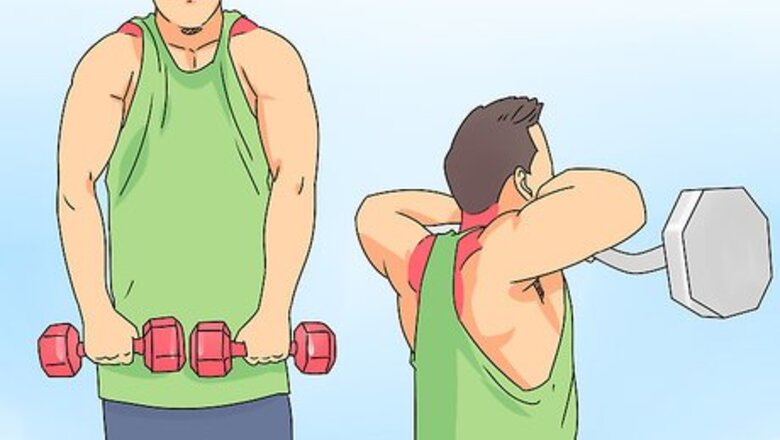
views
Maximizing Your Trap Workouts

Do 2 trap workouts per week, with adequate rest days. To get the best results, it's important to neither under-work nor overwork your traps. For most people, 2 trap workouts per week is the ideal amount. Each trap-focused session should last roughly 20 to 30 minutes. Rest your traps for 3 days between sessions. For instance, work your traps on Monday, Friday, and the following Tuesday. You can do other strength-training sessions in between but don't overwork your traps while focusing on adjacent areas like your back and shoulders. If your traps remain sore or tight up to the time of your next trap workout, cut back on your workout frequency, intensity, or both. If you feel moderate pain during a trap workout, stop and rest the area for a few days. If you feel severe pain, stop and contact your doctor.
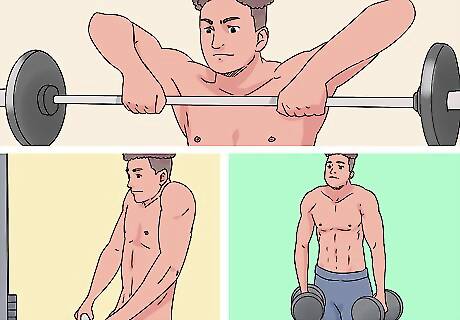
Limit yourself to 8 separate trap exercises per workout. As with the twice-per-week workout schedule, this seems to be the “magic number” for getting the best results. In most cases, doing 8 separate exercises will give your traps a full workout without overworking them. This doesn't mean you have to do the same 8 exercises during every trap workout, though. You may have 2 or 3 exercises that you want to do every time, but feel free to mix things up! Different trap exercises train the muscles in subtly different ways. If you're just starting out, you may want to begin with 4-5 separate trap exercises per session, and then build up to 8 over the span of several weeks.
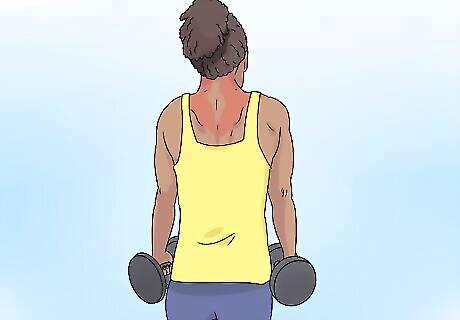
Use lighter weights for full, slow muscle contractions with proper form. Your trap muscles play a part in a wide range of strength-training exercises, but it takes a little extra focus and care to target them specifically. To get the most from your trap exercises, you need to slowly and fully contract and release them—and that's easier to do if you're not maxing out on your dumbbells or barbell. For most trap exercises, you want to take 1-2 seconds to contract the muscles, hold the muscle contraction for 2-3 seconds, take 1-2 seconds to release them, then pause 2-3 seconds before the next repetition (rep). If you have to jerk the weights or rush through the exercises with poor form, choose lighter weights. Use weights that make doing the exercise a greater physical challenge without negatively impacting your form. Take special care to focus on your grip, body positioning, and breathing. Use a mirror or, even better, work with a personal trainer for at least a few sessions so you can perfect your exercise form.
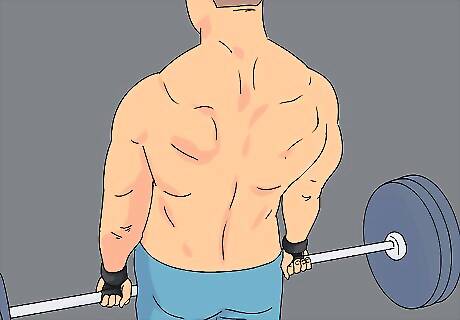
Use gloves or wrist grips to focus more on form and less on grip. Many trap exercises involve holding weights to your sides or in front of you, which means a good grip is essential. A good set of lifting gloves will help, or you can try wrist grips. That way, you don't have to worry about losing your grip while targeting your traps. Don't use wrist grips as an excuse to lift heavier weights than you can handle, though. Your form will suffer and you'll probably injure yourself. You can buy gloves or wrist straps online or at any sporting goods or fitness supply store. Keep in mind that wrist straps will not help you build up functional strength in your wrists, so some people see them as a crutch.
Barbell and Dumbbell Exercises
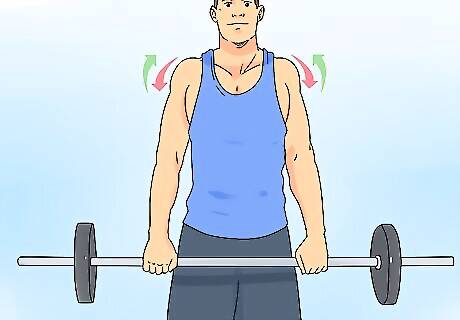
Do shoulder shrugs with a barbell. Grasp a barbell (with or without weights attached) and hold it at thigh level while standing upright with your feet shoulder-width apart. Without moving the rest of your body, slowly raise your shoulders up as high as you can, and hold the shrug for 2-3 seconds. Slowly release the shrug and repeat. Do 3-4 sets of 10-12 repetitions (reps) each, waiting 1-2 minutes between sets. You can use dumbbells instead of a barbell if desired. Hold the dumbbells so that your knuckles are facing forward, the same as they would be when holding a barbell.
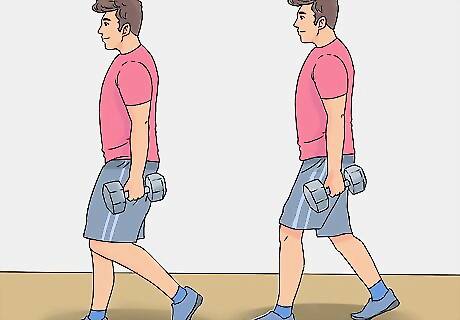
Try doing a farmer's walk with dumbbells. Grasp a dumbbell in each hand and hold them at your hips, palms facing in. Maintain an upright stance and start walking at a steady pace. Don't swing your arms back and forth—keep the weights pinned to your sides. Aim to walk for about 50–100 yd (46–91 m). Do this walk 2-3 times total, waiting 2-3 minutes between walks. At an average walking pace, you can cover 100 yd (91 m) in about 1 minute. Your ultimate goal should be to use dumbbells with a combined weight that is equal to (or even greater than) your body weight. Start with a lower weight amount and work your way up, however. Use gloves or wrist grips for safety as well. Keep your shoulders squared and avoid letting them drop or roll forward as you do this.
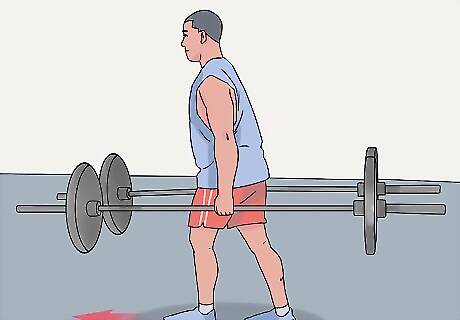
Advance to doing farmer's walks with barbells instead. Once you're fully comfortable doing farmer's walks with dumbbells, try doing them while grasping barbells in each hand instead. Grab the barbells right in the middle, and start without adding any weight to them. Keeping the bars level and balanced while you walk will increase the difficulty and impact of this exercise. Walk for 30–60 yd (27–55 m) at a slow, steady pace. Focus on keeping the bars steady and level. Do 2-3 sets, with 3-4 minutes between sets—these will really work your muscles!

Use dumbbells for bent-over lateral raises. Hold a dumbbell at each hip, keeping your knees at shoulder width and bent slightly, and your back straight but bent slightly forward. With your palms facing your hips, bend your elbows slightly and raise the dumbbells to your sides, raising them as close to parallel with your shoulders as you can. Hold the pose for up to about 1 second, then slowly return to the starting position. Focus on your shoulder blades as you do the maneuver, and try to bring them together as much as possible. Do 3 sets of 10-12 reps, waiting 1-2 minutes between sets.

Do hex bar deadlifts if you have access to a hex bar. Stand inside the hexagonal frame with your feet hip-width apart. Keep your back straight as you lean forward and bend your knees to grip the handles to the sides of the hexagon. Puff your chest out and look straight ahead as you lift the weight and stand fully upright. Hold the lift for about 1 second, then slowly lower the hex bar to the starting position. A hex bar looks a bit like this: -⇔-; and you stand inside the hexagon while lifting up the bar and any weights you've placed on the ends of the bar extensions. A hex bar more evenly distributes the weight around your body, making these deadlifts easier on your lower back and safer overall than traditional deadlifts. If you are properly trained, however, you can do classic deadlifts instead. Do 2-3 sets of 3-6 reps, then finish up with 1-2 sets of 10-12 reps. Rest for 1-2 minutes between sets.
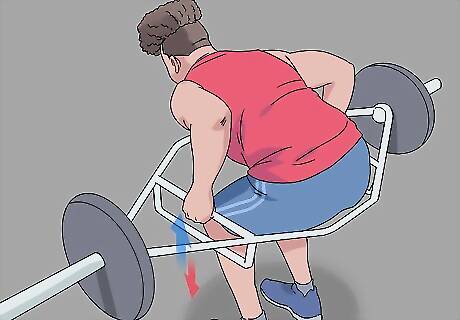
Do bent-over rows with a hex bar or barbell. Set up in the same position as with the deadlifts, and lift the weight so that you're standing upright while holding the bar at your upper thighs. Keeping your knees slightly bent and your back straight, bend at the waist so that your upper body is nearly parallel to the floor. While maintaining your firm hold on the bar, bring your hands up to the sides of your chest, hold them in position for 1-2 seconds, then slowly lower them until your elbows are only slightly bent. Bring the weight slowly back up to your chest to start another rep. As with deadlifts, a hex bar is a safer choice than a traditional barbell for bent-over rows. Work slowly, breathe deeply and focus on squeezing your shoulder blades together with each lift. Do 3-4 sets of 6-10 reps, and wait 1-2 minutes between sets. Upright rows are another great way to keep your trap muscles functional for day-to-day life. If you can do 15 reps of upright rows with 50 kg (110 lb), you actually have over 500 lb (230 kg) of strength.
Body-Weight and Machine Exercises
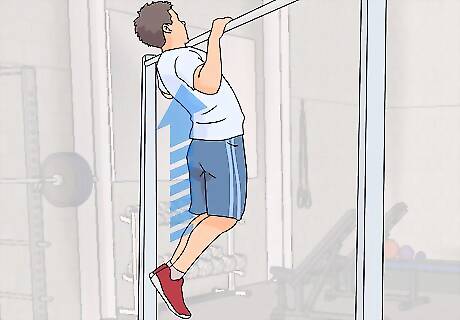
Do slow-speed pull-ups with pauses to hold each pull-up. Grasp the pull-up bar so that your hands are at shoulder width and your palms are facing outward (also called an overhand grip). Use your arms to steadily pull your body weight upward until your chin is above the height of the bar, hold the pose for 1-2 seconds, then slowly lower your body down to the starting position (with your feet off the floor). Focus on squeezing your shoulder blades together with each pull-up. Holding each pull-up will increase the impact on your traps. Do 3-4 sets of 10-12 reps, waiting 1-2 minutes between sets.
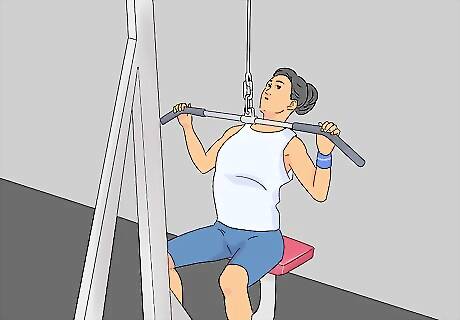
Use a pull-down machine instead of (or alongside) doing pull-ups. Set the height of the pull-down bar so that you can grasp it with both hands at a wider than shoulder width and maintain the proper form: seated on the bench with your feet flat on the floor, your back straight and upright, and your elbows slightly bent. Slowly pull the bar down in front of your face and touch your upper chest, hold the pull for 2-3 seconds, then return to the starting position. Don't lean back when you pull the bar down—keep your back still and straight. Instead, squeeze your shoulder blades together as you pull. Do 3-4 sets of 10-12 reps, and pause for 1-2 minutes between sets. Pull-downs work essentially the same muscle groups as pull-ups, but many people find them easier to do with proper form.
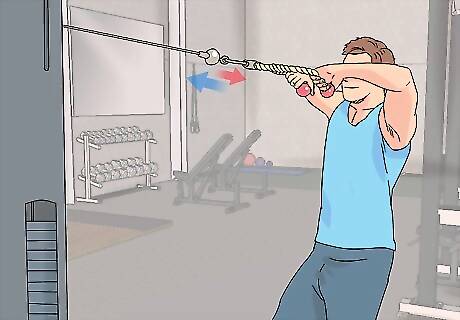
Set up a cable machine to do face pulls. Attach a rope to a cable machine and grasp the ends of the rope while standing or sitting. Adjust your position and the height of the machine so that your arms are extended and parallel to the floor—your elbows should be only slightly higher than your wrists. Slowly pull the rope towards your face, bringing your hands to the sides of your chin if possible. Hold the pose for 2-3 seconds, then slowly release it. Bend your elbows and pinch your shoulder blades with each pull. Try not to lurch your upper body back and forth. Do 3-4 sets of 12-15 reps, waiting 1-2 minutes between sets. You can do a variation of this exercise by wrapping a resistance band around a support beam or steady metal pole.
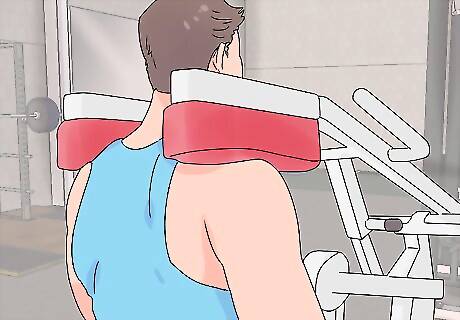
Use a calf machine to do shoulder shrugs. Set up the calf machine so that the pads are resting on the tops of your shoulders while you're standing upright with your feet hip-width apart. Instead of raising your heels to push the pads up, keep your feet flat on the floor and shrug your shoulders upward. Hold the shrug for 1-2 seconds, then slowly release it. Do 3-4 sets of 12-15 repetitions. Rest for 1-2 minutes between sets.



















Comments
0 comment